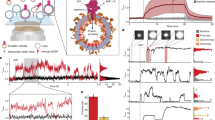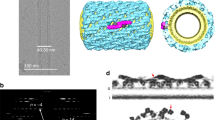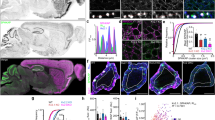Abstract
The regulation of intracellular pH (pHi) is essential for normal cell function1, and controlled changes in pHi may play a central role in cell activation2. Sodium-dependent Cl–HCO3 exchange is the dominant mechanism of pHi regulation in the invertebrate cells examined3–6, and also occurs in mammalian cells7,8. The transporter extrudes acid from the cell by exchanging extracellular Na+ and HCO3− (ref. 9) (or a related species) for intracellular Cl− (refs 3, 4). It is blocked by the stilbene derivatives DIDS (4,4′-diisothiocyano-stilbene-2,2′-disulphonate, ref. 10) and SITS (4-acetamido-4′-isothiocyano-stilbene-2,2′-disulphonate, ref. 3), and has a stoichiometry of two intracellular H+ neutralized for each Na+ taken up and each Cl– extruded by the axon11. Because the inwardly-directed Na+ concentration gradient is sufficiently large to energize both the HCO3− influx and Cl− efflux, this electroneutral exchanger could be a classic secondary active transporter, thermodynamically independent of ATP hydrolysis. However, at least in the squid axon, the exchanger has an absolute requirement for ATP (ref. 3). Thus, a major unresolved issue is whether this Na-dependent Cl–HCO3 exchanger stoichiometri-cally hydrolyses ATP (the pump hypothesis), or whether ATP activates the transporter by a mechanism such as phosphorylation or simple binding (the activation hypothesis). We have now explored the role of ATP in pHi regulation by dialysing axons with the ATP analogue ATP-γ-S. In many systems, ATP–γ–S is an acceptable substrate for protein kinases12,13, whereas the resulting thiophosphorylated proteins are not as readily hydrolysed by phosphatases as are phosphorylated proteins14,15. Our results rule out the pump hypothesis, and show that the basis of the axon's ATP requirement is the pH-dependent activation (by, for instance, phosphorylation or ATP binding) of the exchanger itself, or of an essential activator.
This is a preview of subscription content, access via your institution
Access options
Subscribe to this journal
Receive 51 print issues and online access
$199.00 per year
only $3.90 per issue
Buy this article
- Purchase on Springer Link
- Instant access to full article PDF
Prices may be subject to local taxes which are calculated during checkout
Similar content being viewed by others
References
Roos, A. & Boron, W. F. Physiol. Rev. 61, 296–434 (1981).
Moolenaar, W. H. A. Rev. Physiol. 48, 363–376 (1986).
Russell, J. M. & Boron, W. F. Nature 264, 73–74 (1976).
Thomas, R. C. J. Physiol., Lond. 273, 317–338 (1977).
Boron, W. F., McCormick, W. C. & Roos, A. Am. J. Physiol. 240, C80–C89 (1981).
Moody, W. J. Jr J. Physiol., Lond. 316, 293–308 (1981).
L'Allemain, G., Paris, S. & Pouyssegur, J. J. biol. Chem. 260, 4877–4883 (1985).
Rothenberg, P., Glaser, L., Schlesinger, P. & Cassel, D. J. biol. Chem. 20, 12644–12653 (1983).
Boron, W. F. & De Weer, P. Nature 259, 240–241 (1976).
Thomas, R. C. Nature 262, 54–55 (1976).
Boron, W. F. & Russell, J. M. J. gen. Physiol. 81, 373–399 (1983).
Gratecos, D. & Fischer, E. H. Biochem. biophys. Res. Commun. 58, 960–967 (1974).
Sun, I. Y., Johnson, E. M. & Allfrey, V. G. J. biol. Chem. 255, 742–747 (1980).
Hauptmann, M., Winson, D. F. & Erecinska, M. Biochem. Pharmac. 8, 1247–1254 (1985).
Brooks, J. C. & Brooks, M. Life Sci. 37, 1869–1875 (1985).
Brinley, F. J. Jr & Mullins, L. J. J. gen. Physiol. 50, 2303–2331 (1967).
Hinke, J. A. M. in Glass Electrodes for Hydrogen and Other Cations. Principle and Practice. (ed. Eisenman, G.) 464–477 (Dekker, New York, 1967).
Boron, W. F. & De Weer, P. J. gen. Physiol. 67, 91–112 (1976).
Yates, D. W. & Duance, V. C. Biochem. J. 159, 719–728 (1976).
Yasuoka, K., Kawakita, M. & Kaziro, Y. J. biochem., Tokyo 91, 1629–1637 (1982).
DiPolo, R. & Beauge, L. Biochem. biophys. acta 897, 347–354 (1987).
Author information
Authors and Affiliations
Rights and permissions
About this article
Cite this article
Boron, W., Hogan, E. & Russell, J. pH-sensitive activation of the intracellular-pH regulation system in squid axons by ATP-γ-S. Nature 332, 262–265 (1988). https://doi.org/10.1038/332262a0
Received:
Accepted:
Issue Date:
DOI: https://doi.org/10.1038/332262a0
This article is cited by
-
ATP Dependence of Na+-Driven Cl–HCO3 Exchange in Squid Axons
Journal of Membrane Biology (2008)
Comments
By submitting a comment you agree to abide by our Terms and Community Guidelines. If you find something abusive or that does not comply with our terms or guidelines please flag it as inappropriate.



